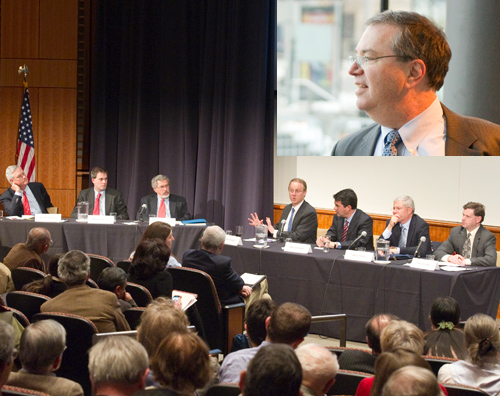For those who enjoy political theater, the national healthcare debate with its roster of heroes and villains and plot twists (e.g., the Massachusetts special election) has not disappointed. But good theater and cogent debate rarely coexist. To add a measure of thoughtful discussion to the mix, Jeffrey Flier, dean of the Faculty of Medicine, invited a group of visiting experts and Harvard scholars to debate the subject at the Medical School’s Martin Conference Center on Jan. 11. Speakers at the standing-room-only event were David Cutler, Harvard University professor of economics; Allan Detsky, professor in health policy, University of Toronto; David Goldhill, president and CEO of the Game Show Network; and Daniel Kessler, professor in management, Stanford University.
Health Care Reform Symposium Video (Requires RealPlayer)
Flier and Barbara McNeil, chair of the HMS Department of Health Care Policy, moderated. A subpanel consisting of Michael Chernew, HMS professor of healthcare policy; William Sahlman, professor of business administration at Harvard Business School; and Leonard Schaeffer, professor at the University of Southern California, concluded the event with a series of questions for the speakers.
A Flawed FoundationThe presenters, with one exception, were not hopeful about the prospects of meaningful reform, blaming everything from a flawed funding structure to a dysfunctional political process.

The latter was argued by Allan Detsky, who explained that the main problem facing healthcare reform in the United States involves the country’s governmental structure. He said it is far easier to approve legislation under a parliamentary system in which the executive and legislative branches are “always together” when there is a majority government.
David Goldhill began exploring the healthcare industry in depth after his elderly father died from a hospital-acquired infection, which he wrote about for the Atlantic Monthly in an article titled “How American Healthcare Killed My Father.” Goldhill sees the current bill as simply expanding a broken system. He argued that the U.S. healthcare system is a world unto itself, a world with its own language and rules. It is an island in our economy with incentive structures that, in any other context, would seem bizarre. For instance, it is one of the only economic spheres in which technological advances drive costs up and not down and create greater, not less, complexity.
The current bill is about coverage, not care.
“Insurance is a form of finance,” he said. “It is the most administrative, costly, financially distortive form of financing that exists. It is why, outside of healthcare, it is only used for things that are rare, unpredictable and major. In healthcare we use it for everything.”
His recommendations for reform included establishing a national catastrophic policy, requiring that people save for their healthcare and pay for part of it, and drawing consumers, who “need to be more empowered,” back into the system.
Point, CounterpointWhile the event was a symposium and not a debate, the first and last presentations were the most partisan, representing opposing ends of the political spectrum.
David Cutler, who was senior healthcare adviser to Barack Obama’s presidential campaign, was cautiously optimistic.
A major problem in our current system is inefficiency and waste, he said. As an example, he pointed out that Duke University Medical Center has 900 hospital beds and 1,300 billing clerks. There is no data showing that such increased overhead results in better patient outcomes.
According to Cutler, the answer is to target the supply side, not the demand side. We all know, for example, that medical spending varies hugely among demographic regions. These differences, said Cutler, are not due to patient demands but rather to the varying incentives that hospitals have in different regions of the country.
Targeting the supply side is more precise and effective than targeting the demand side. Data shows that hospital admittance drops when hospitals have incentives not to keep patients for long periods. But if you target the demand side with, say, price incentives, patients will often not act in their best interests. They may, for example, switch to cheaper and less effective medications and therapies.
The current plans include reforms that bundle payments for patients, once scattered across providers, into one place. They also incorporate performance payments into Medicare by only rewarding providers who deliver solid service and offer a holistic approach to healthcare—one that helps guide patients through “the most complicated system of any industry in the economy.”
“This is a path, not a leap,” he cautioned. “Passing the legislation is only 15 percent of the challenge. The remaining 85 percent is making it work.”
Kessler, the final speaker, disagreed almost entirely with Cutler. Kessler claimed that not only will the proposals cause fiscal problems, but, he said, it is not even certain that health insurance improves health.
Specifically, he said that the plans create another middle class entitlement program, massive work disincentives by creating an implicit marginal tax rate and, in addition, openings for increased government involvement in people’s private lives.
Kessler conceded that while conventional commercial insurance coverage is not a sustainable solution, he could not offer a workable alternative.



